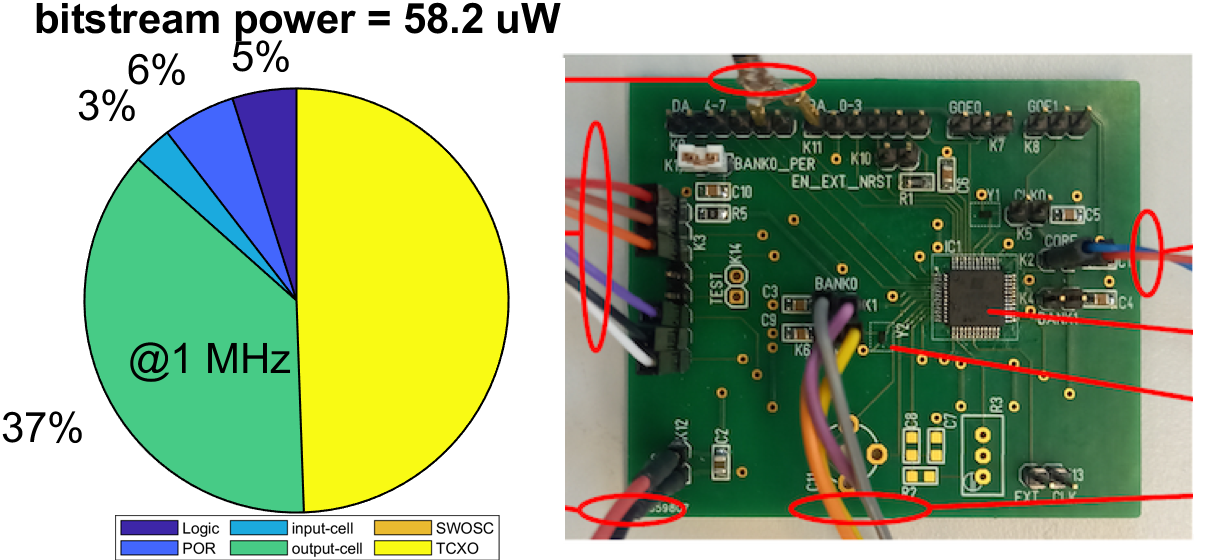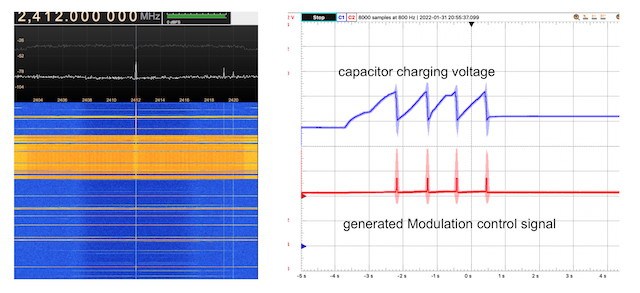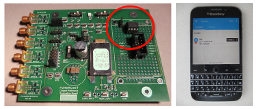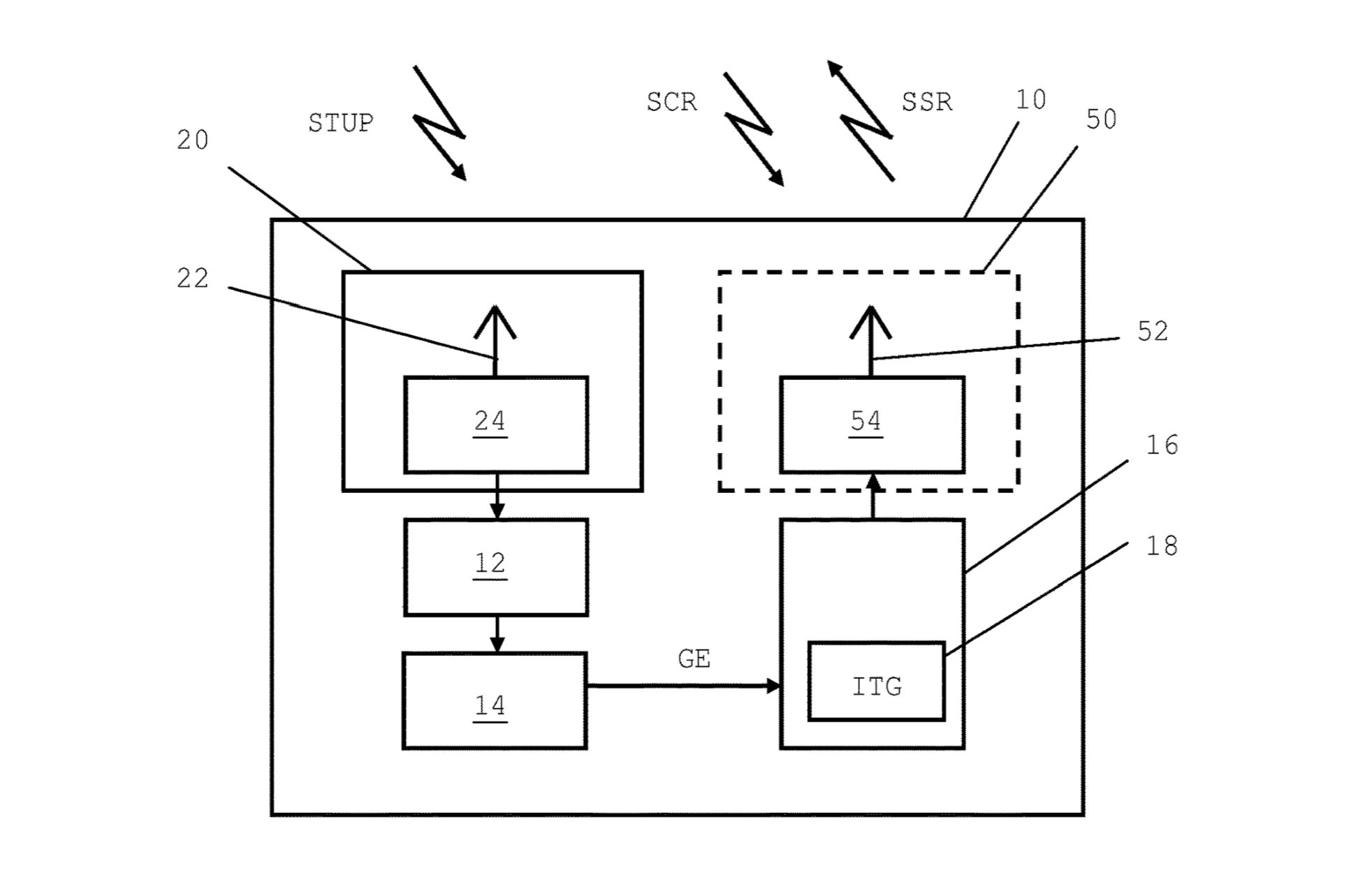| Nr. | Status | Description | Figures | Further Information |
|---|---|---|---|---|
| 27 | oral presentation, completed |
Scattering Bluetooth Messages between Battery-less Transponder and Mobile Telephones This work concerns the operation of a battery-less transponder operated by intentionally generated wireless signals in the 2.4 GHz ISM band. The wireless signals consist of a power supplying data stream and special Bluetooth messages. In response, the transponder back-scatters these messages to a conventional Bluetooth receiver. Our implementation uses two regular mobile telephones, one for transmitting the wireless signals, the other for receiving the scattered signals. The back-scattering applies frequency shifting of the incident Bluetooth messages for separating transmission and receiving processes. The special Bluetooth messages include specifically designed bit sequences that by themselves serve as short Bluetooth messages that are appropriately coded for detection by the Bluetooth receiver. In effect, generation of response messages is delegated from the battery-less transponder to the transmitting telephone. Experiments show that 2 MHz frequency shifting achieves better performance and/or efficiency than 4 or 6 MHz shifting, the latter based on third harmonics. At 2 MHz, the active power consumption of the transponder is 347 μW and the wireless operational range reaches 6 cm, which is a 50% improvement over our previous work. Thus, the proposed design improves basic communication between a battery-less transponder and mobile telephones, which encourages further endeavors in this direction. |


|
IEEE RFID-TA Conference, Daytona Beach, USA 2024 IEEE Publication |
| 25 | extended paper, completed |
Implementations for Scattering at 1.8 Volt between Battery-less Transponder and Mobile Telephones Extended study for comparing advanced implementation techniques: Micro Controller Unit (MCU), FPGA (Field Programmable Gate Array), CPLD (Complex Programmable Logic Device) and ASIC (Application Specific Integrated Circuit) and for implementing a CPLD test version. Experimental results suggest that our CPLD is more suitable than MCU or FPGA implementations. The paper further demonstrates the transition from a fully synchronous to a low-power asynchronous CPLD implementation. The measured power consumption for generating the bit-stream is 87 μW, which results in a 6-fold reduction compared to our previous MCU based setup. Research Partner: Institute for Microelectronics and Embedded Systems (IMES), Eastern Switzerland University of Applied Sciences, Rapperswil, Switzerland Support: Innosuisse, Swiss Innovation Agency, Bern, Switzerland |

|
IEEE Journal of Radio Frequency Identification, 2024 IEEE Publication |
| 24 | oral presentation, completed |
RF Harvesting for Scattering at 1.8 Volt between Battery-less Transponder and Mobile Telephones
We compare different implementation technologies for bitstream generation and subcarrier modulation: hardware, microprocessor (MCU) as well as digital and analog designs. Experiments show that the combination of MCU and switchable analog subcarrier generator shows the most promising result with an active power consumption of less than 1.2 mW with a wireless range extension to 4 cm. |

|
IEEE RFID-TA Conference, Aveiro, Portugal 2023 IEEE Publication |
| 23 | project, completed |
Comparative Study Concerning Feasibility and Potential Advantages of Different Circuit Implementation Techniques The study involves relatively low-cost measures in the area of software, alternative architectures and components in the area of discrete electronics and estimations of the power consumption of an ASIC-implemention. Research Partner: Institute for Microelectronics and Embedded Systems (IMES), Eastern Switzerland University of Applied Sciences, Rapperswil, Switzerland Support: Innosuisse, Swiss Innovation Agency, Bern, Switzerland |

|
INNOSUISSE Registration |
| 21 | oral presentation, completed |
Harvesting Data Streams for Scattering between Battery-less Transponder and Mobile Telephones
WLAN signals provide a continuous data stream coexisting with BLE 5.0 advertising signals. Alternative data transfer protocols and different WLAN transmission frequencies have been studied. Results show that the User Datagram Protocol (UDP) over WLAN provides high duty cycle transmissions at an operational range of approx. 2 cm without interfering scattering. |

|
WPW 2022 Conference, Bordeaux, France 2022 IEEE Publication |
| 18 | oral presentation, completed |
RF Harvesting at 2.4 GHz for Scattering between Battery-less Transponder and Mobile Telephones
WLAN broadcast signals from the transmitting mobile telephone provide an additional source of energy for our battery-less transponder. An Android specific form of WLAN tethering shows the most promising potential for our scattering application based on regular, unmodified mobile telephones. |
|
IEEE RFID-TA Conference, Delhi, India, 2021 (virtual) IEEE Publication |
| 15 | oral presentation, completed |
Harvesting for Scattering Bluetooth-Signals between Battery-less Transponder and Mobile Telephones The transmitting mobile telephone sends extended Bluetooth advertizing messages and their periodic retransmissions according to the BLE version 5.0. A specifically designed code sequence generates a quasi-continuous wave signal of approx. 2 ms duration, which provides the basis for the back-scattering process. Support: Transport at Nanoscale Interfaces Laboratory of Swiss Federal Laboratories for Materials Science and Technology |

|
Wireless Power Transfer Conference (WPTC), Seoul, South Korea, 2020 (virtual) IEEE Publication |
| 13 |
oral presentation, completed |
Harvesting for Scattering Modulated RF-Signals Receivable by Mobile Telephones A micro-controller (MCU) of a transponder is operated by using energy of RF harvesting circuit, an external 1 MHz crystal and an internal asynchronous RC oscillator for generating a frequency shift keying modulated subcarrier. The MCU consumes 9.2 mW during active operation. |

|
Conference, Wireless Power Week (WPW) London, UK, 2019 IEEE Publication |
| 10 |
poster presentation, completed |
Harvesting for Scattering RF-Signals receivable by Mobile Telephones A battery-less transponder combines RF (radio frequency) harvesting and RF scattering to modulate an incident continuous wave signal such that the scattered signal is receivable by a Bluetooth Low Energy (BLE) receiver of a regular, unmodified mobile telephone. |
 |
Wireless Power Transfer Conference (WPTC) Montreal, Canada, 2018 IEEE Publication |
| 07 |
poster presentation, completed |
Energy Harvesting in EM Fields
The project involved evaluating the potential of energy harvesting in different wireless communication environments and implementing a harvesting circuit by specifically designing antenna, matching circuit and voltage multiplier. The harvested power was sufficient to operate a pocket calculator. Project at FHO-HSR (University of Applied Sciences), Rapperswil, Switzerland with idp invent ag as project partner |
 |
|
| 05 | Patents for Sale/License | Transponder tag that is operable by a mobile telephone, portable object, mobile telephone, and corresponding methods Transponder Tag for receiving wireless signals at a frequency of a local wireless network (ISM radioband), configured to use the energy of these signals for transmitting tag information to a mobile telephone via a short-range RFID connection. This is particularly useful for numerous short distance applications, e.g. for obtaining a quick confirmation that all needed personnel belongings (keys, medical box etc.) are "on board" when leaving home/office. |
 |
|
| 01 | Patents for Sale/License | Method of operating an RFID-enabled mobile telephone, mobile telephone, remote unit and application program product RFID-enabled Mobile Telephone for quickly and conveniently checking the nearby presence of correspondingly tagged portable objects (keys, medicine box etc.), e.g. before leaving home or office, and a wristwatch for remotely controlling such a telephone |
 |